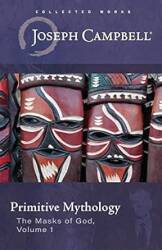
Haguromachi Touge
Haguromachi Touge, The Pilgrimage and Training Town
During the Edo Period, when the Emperor was cloistered in
Kyōto and the Shōgun ruled Japan from his
capital in Edo, today's Tōkyō,
this area was a major spiritual destination.
Tens of thousands of pilgrims came here to visit the many
shrines, especially those on the peaks of the three holy
mountains of Dewa —
Haguro-san,
Gas-san,
and
Yudono-san.
Haguromachi Touge,
the town at the base of Mount Haguro,
was a training center for the syncretic
Shugendō
faith and the
Yamabushi
mountain monk practices.
Now many of the training lodges have been converted to
ryokan or traditional inns,
but some remain shukubo,
pilgrim lodges for training and purification.
Here are some pictures from strolls through the town
and a visit to a prominent Buddhist temple.
Shukubo Pilgrim Lodges and Other Accommodations
The bus I rode from the train station in Tsuruoka had passed through a very large vermilion torii that spanned the highway. As always, that marked a passage into a more sacred space, into the pilgrim and training town at the base of Mount Haguro.
Shugendō is a syncretic faith, mixing beliefs and practices of the shamanic mountain worship brought in from the north during the Last Glacial Maximum around 26,000–20,000 years ago, Shintō and its kami worship predecessor that arrived with the Yayoi people crossing from the Korean peninsula starting in 1000–700 BCE, and elements of Buddhism and Taoism that arrived from China around 300–500 CE.
An agent of the Soga clan assassinated Emperor Sushun in 592 CE in the Imperial capital near today's Nara. His first-born son, Prince Hachiko, fled north to the coast, then by ship northeast along the coast. He landed in today's Tsuruoka, well beyond the reach of Imperial government power and any associated assassins.
Hachiko was supposedly guided by the supernatural three-legged crow Yatagarasu, who was also credited with guiding Jimmu, the first Emperor and direct descendant of the sun goddess Amaterasu. Hachiko came inland to Mount Haguro and became aware of Haguro Gongen, the god of the mountain. Hachiko founded the first shrine, which became the Dewasanzan Shrine.
The town here thrived during the Edo period of 1603–1868. It was a major spiritual destination with tens of thousands of pilgrims from all around Japan visiting every year. There were over 360 pilgrim lodges, called shukubo.
All that was shut down with the Meiji Restoration of 1868 when Shintō was redefined and newly enforced, emphasizing the Emperor's divine nature. What the Allies called "State Shintō" during World War II ended in 1945. Most people had lost track of the details of Buddhism and pre-Meiji Shintō, let alone the kami worship that had arrived with wet-rice agriculture and the Japonic language family. But the surviving Buddhist clergy and the much less numerous Shugendō mystics were allowed to re-establish their practices.
Today there are only 29 shukubo pilgrim lodges operating in town, offering the Yamabushi mountain training programs. Many former shukubo have been converted to more conventional ryokan or traditional inns.
This is an operating shukubo. You can tell by the shime, hemp rope around the torii gate with hemp tassles and shide or paper zigzag strips hanging down. All of that is Shintō symbolism, in this town it more specifically indicates a facility offering rather Shintō-focused Shugendō training.
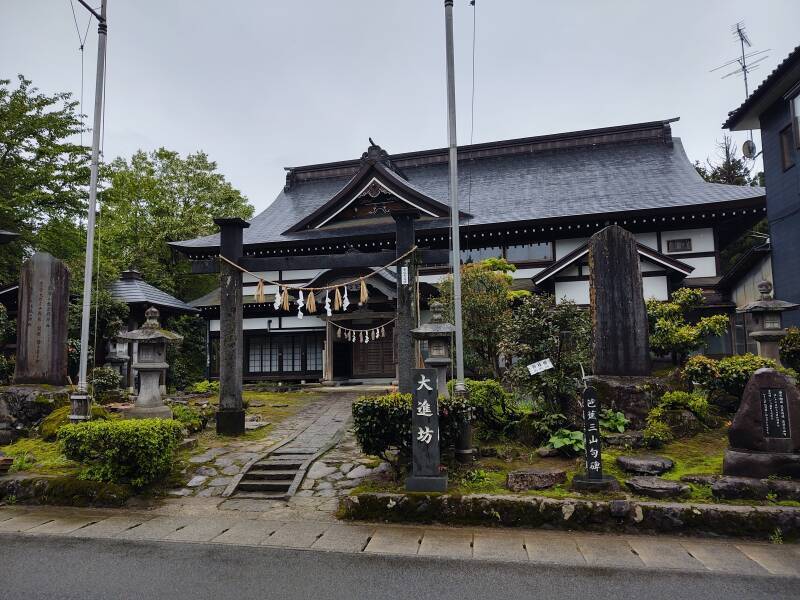
Here's a walkway leading off the main street to a shrine.
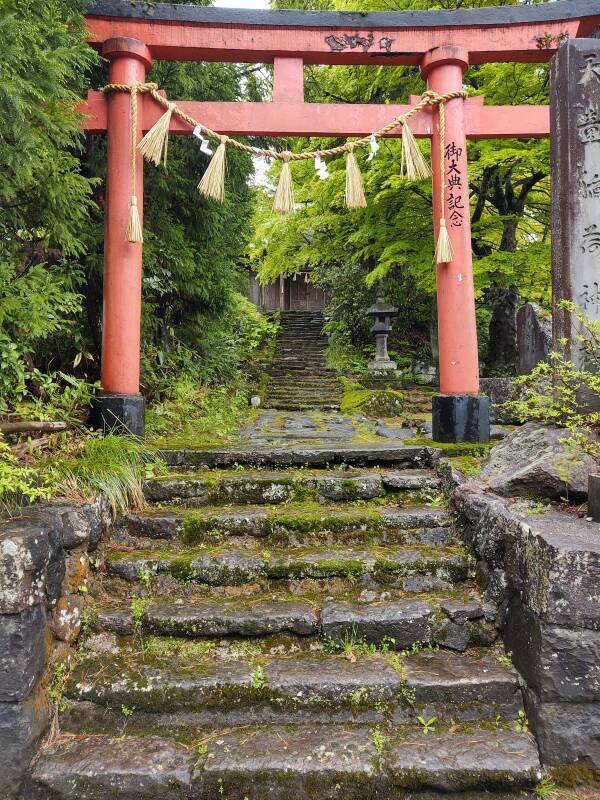
The remaining shukubo are largely concentrated along the main road through town.

North From My Ryokan
Guesthouses at Booking.comHere's the Tamonkan ryokan where I stayed. It's along the main road through town where it goes through a Z-curve. From here I'll walk off to the right, away from the mountain toward the north end of town.
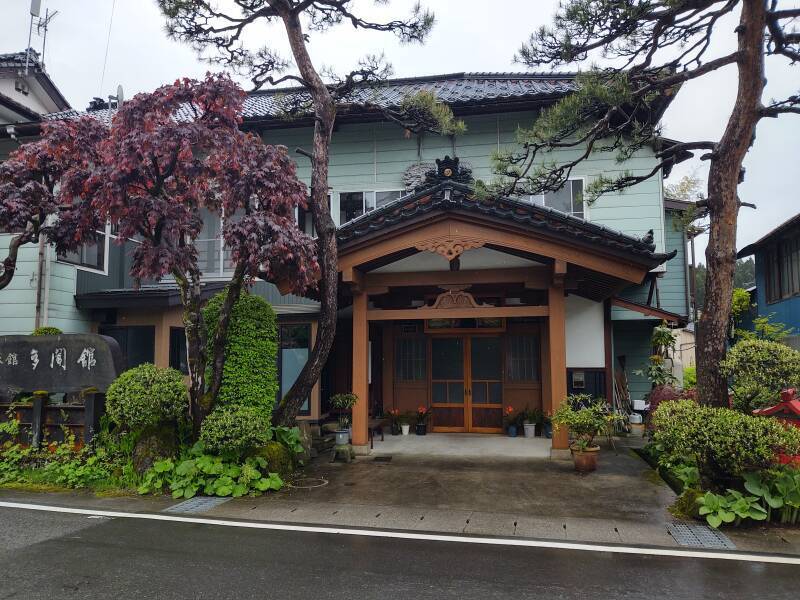
A post office, small shop, and bank machine share a building. The red symbol that resembles a katakana テ or te indicates a post office. There's one on the sign, one on the red van, and there will be one on the orange mailbox.
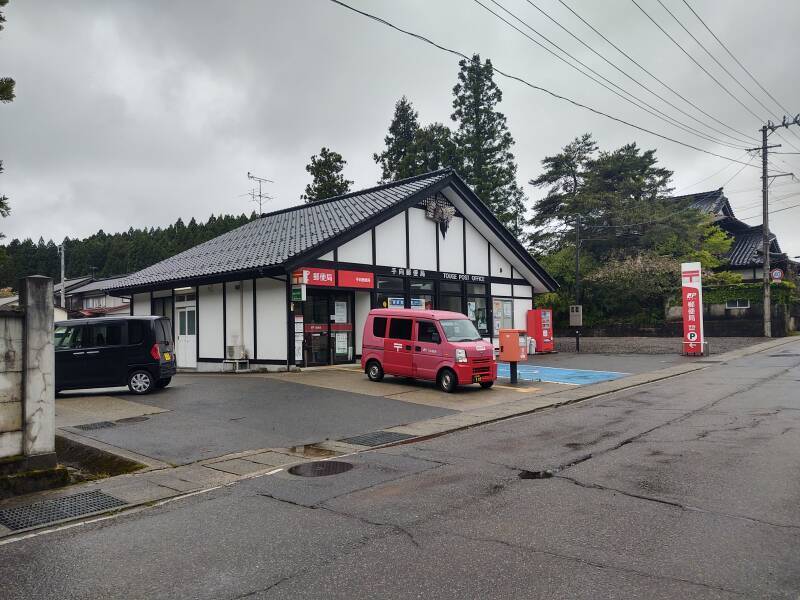
I continued further along the main road, then turned to look back past the post office.

In the picture above you can see that there's a bicycle lane alone the road, and then what serves as a narrow sidewalk. It has a series of concrete panels with narrow slots at each end, and widely spaced metal grills along its length. It's the sidewalk, and it replaces the gutter by being the lid or roof on a rectangular drainage channel. That connects into a storm drain system every few blocks.
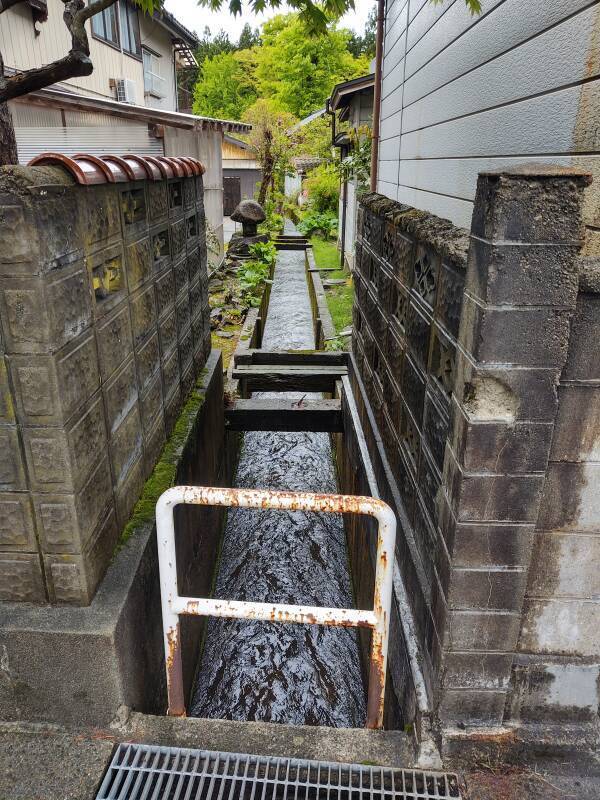
Many major Japanese cities were devastated by incendiary bombing raids during the Second World War. Small towns of no military importance like this one preserve early to mid 20th century architecture, and older.
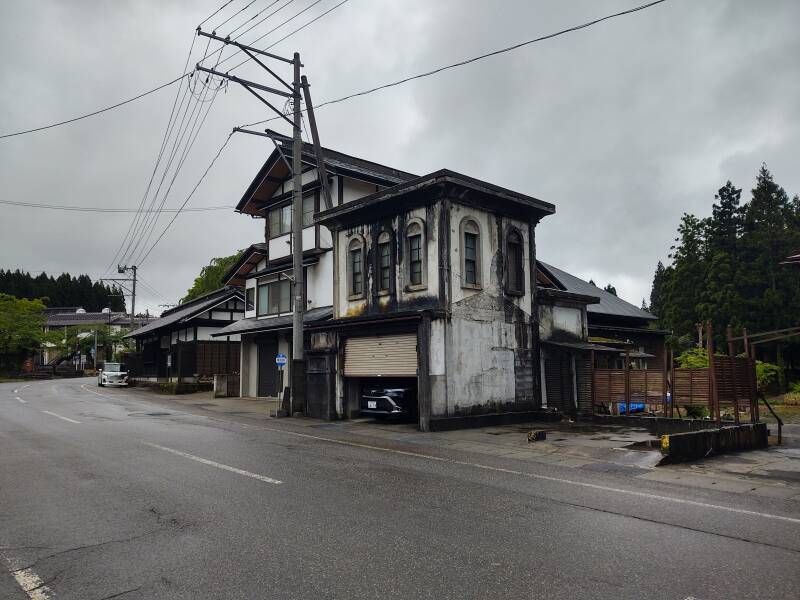
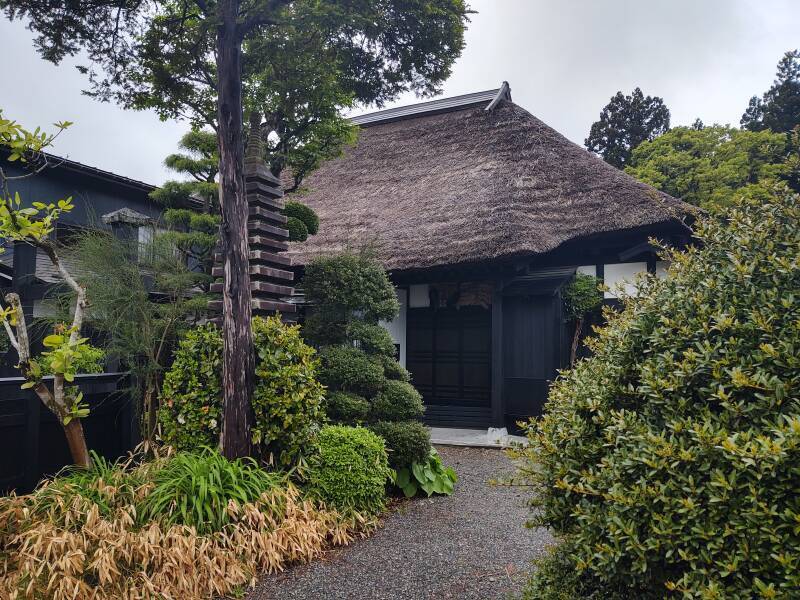
Shozen-in, the Shozen Temple and its Golden Hall
The Shozen-in Buddhist temple is the main cultural site within the town itself. It was once classified as a National Treasure but has been downgraded to a National Important Cultural Property, I assume because of it being Buddhist and not Shintō.
Its main hall, the Kogane-do, is said to have been built with a contribution from Minamoto no Yoritomo. He was the founder and first Shōgun of the Kamakura shōgunate, making him the first Shōgun of Japan. He ruled 1192‐1199. He would have funded this temple to support his military campaign to consolidate power through the 1180s.
VisitingKamakura
Kamakura today is a nice beach town southwest of Tōkyō, close enough to visit as a day trip but with enough Zen Buddhist temples plus a gigantic Buddha statue that you could easily fill a few days there, as I did. It's hard to realize that it was the 4th largest city in the world when it was the home of the Shōgunate.
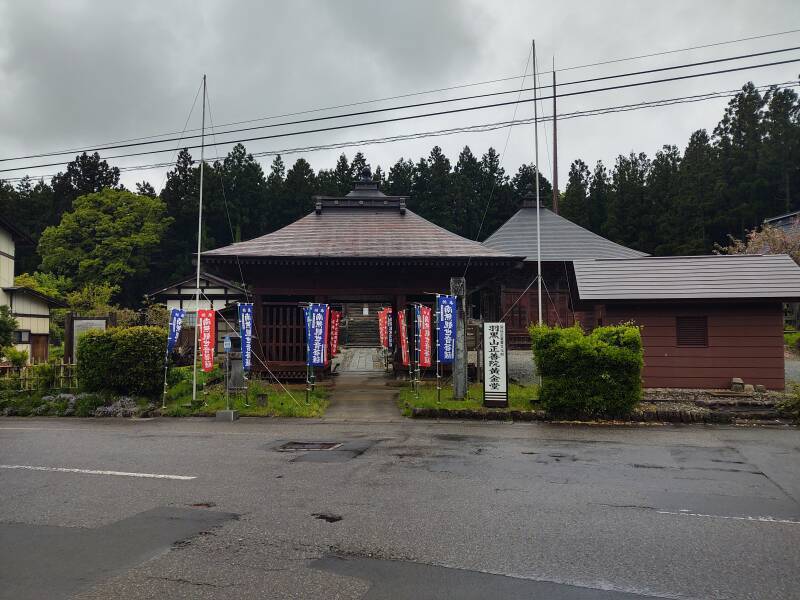
A Buddhist temple is typically protected by a mon or gate. That's the structure with the red and blue banners in the above picture.
Usually the two sides of the gate have Niō figures, fierce protectors. They are Hindu deities who have been incorporated into Buddhism as protectors against evil spirits. Their fierce appearance keeps demons and thieves out of the temple grounds. Agyō stands to the left as you enter, wielding a vajra or thunderbolt, and Ungyō is on the right, empty-handed or wielding a sword.
You almost always find that the protector on your left has an open mouth, pronouncing the sound of the Sanskrit letter अ or A, while the protector on the right has a closed mouth, pronouncing the sound of the Sanskrit latter म or MA. Together they pronounce the sacred syllable Aum or ॐ.
Aum is the sacred sound of Hinduism, but it is also used as a mantra in Buddhist, Jain, and Sikh practice.
The two statues here were originally in the gate at the beginning of the path up Mount Haguro. They were removed and transferred here in 1868.

The passageway through the gate is lined with hemp rope sandals left by pilgrims, symbols of the Buddha.

The temple's bell hangs in an open belfry.

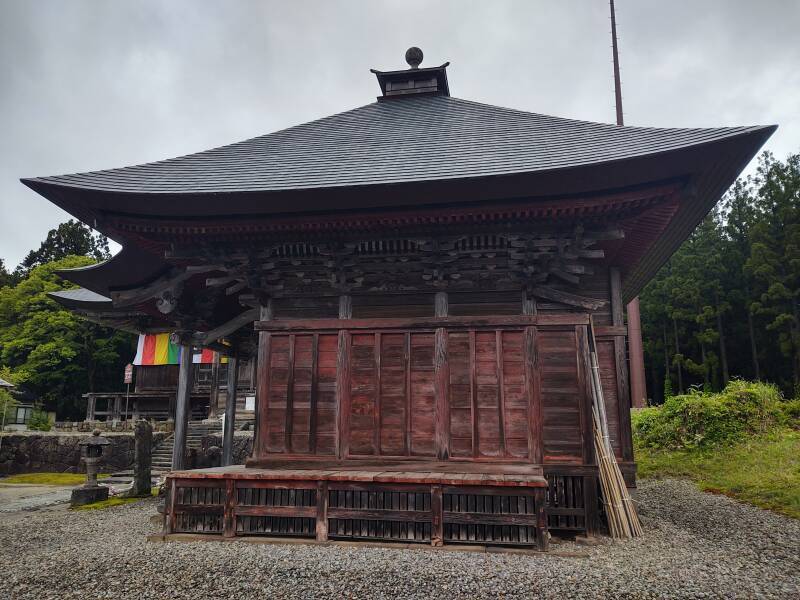
Jizō is a bodhisattva typically depicted as a monk. He is regarded as the guardian of children and the patron deity of deceased children and aborted fetuses. Jizō in Japanese, Kṣitigarbha in the original Sanskrit. People will place red caps and bibs on representations of Jizō as a devotional act.
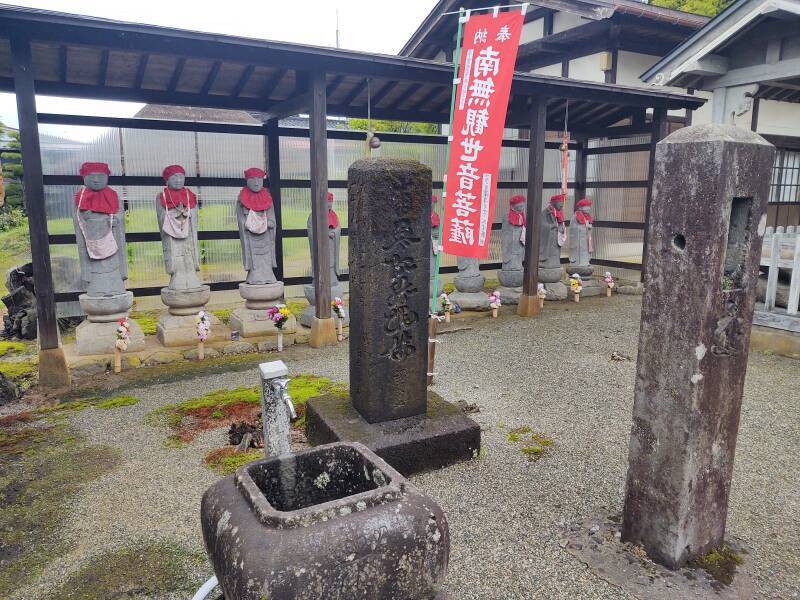
The main hall is named Kogane-do, or Golden Hall. This is the only remaining temple of the Haguro-san Shugendō school of Buddhism. Or put another way, the only Buddhist component that survived the Meiji Restoration. It contains several Buddhist statues that belonged to Dewasanzan before its conversion to Shintō in 1868.
You may think that I have a bit of an attitude about Shintō practice largely being a political invention first done in the early 8th century CE and then again at the Meiji Restoration of 1868, leading to rampant nationalism and military misadventures. Well, you should have been along on this temple visit and met the priest.
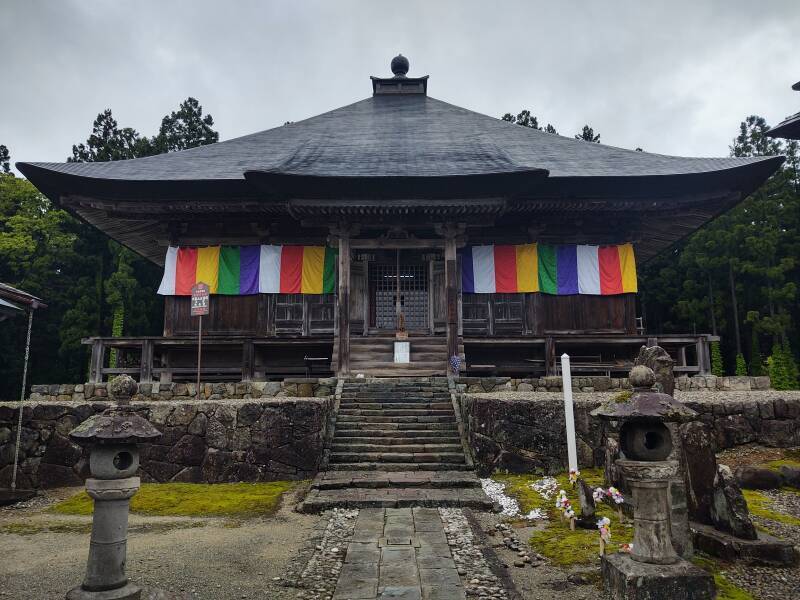
I walked around the temple grounds and looked at the statues and monuments. I could see that there were lighted candles inside. Going up the steps to the porch, I could hear voices.
There were three pairs of shoes at the last steps up to the doors. So, I decided to try, as politely as possible, to enter.
Three older women, the owners of those shoes, were inside, sitting on small stools and talking and laughing with the priest.
There was a lot of どうぞ, どうぞ, or dōzo, dōzo, "please, please" and gesturing for me to enter. Then they went bustling out, giggling and waving, with an air of "Don't mind us, we were just leaving anyway".
The priest was delighted to have a foreign visitor. He knew only a few words of English, but he had an app on his phone that he could speak a phrase into and it would display an English translation.
Through his phone app, he explained that the temple was dedicated to Kannon, and it was known for having 33 golden Kannon statues — 15 to the left, 15 to the right, and a larger 3 at center, filling the front of the sanctuary. Hence the name Kogane-do or Golden Hall.
This is the Bodhisattva of compassion, known as
अवलोकितेश्वर
or Avalokiteśvara in Sanskrit.
In China she was known as Guanyin,
which became Kannon in Japanese.
I asked, "Ah, Avalokiteśvara?",
and he got his phone to show me
"OLD NAME".
And he absolutely lit up,
because he had an interested visitor
who wasn't utterly clueless.
He told me more about Kannon.
Then he sent me around the
"CIRCUIT",
a passage that goes around the central sanctuary.
It's almost like a tunnel between the central sanctuary hall
and the exterior walls,
with a series of Buddha and Bodhisattva statues.
He told me to make sure to notice the main Buddha statue
along each of the left, rear, and right passages.
When I returned to my guesthouse that evening, my innkeeper asked me what I had done that day. He was very impressed to hear about my making the circuit at this temple. Buddhists consider that equivalent to having visited all three of the holy mountains because of the three primary Buddha images, one associated with each peak, in addition to the 33 Kannons.
Then the priest started telling me some things through the phone translation that made me wonder if he was really telling me what I thought he was. Then it became clear that, yes, he was.
He is understandably not at all a fan of Emperor Meiji.
Or, for that matter, Hirohito.
But Meiji kicked off the "Restoration" that led to almost
eight decades of foreign militarism,
and got the most criticism.
"NO RELIGION, ONLY WAR".
I must stress that he brought this up, not me.
I was totally into the belabored explanation of the Bodhisattvas
and was disoriented by the "But then this happened"
sudden turn.
Then he had some complaints about how Buddhism is supposed to be equal today, but is still disadvantaged relative to Shintō.
And then he got into how frustrating it is that the Japanese
people in general don't understand any of this.
They're all confused and think that
Buddhism and Shintō are basically the same thing.
Then,
"FOREIGNERS KNOW MORE THAN JAPANESE PEOPLE KNOW
ABOUT JAPANESE RELIGION".
I'm a visitor to his country,
and so I've tried to understand
what I'm looking at,
and what's going on,
and what I should do in certain situations.
And then I get confused by what I see others doing.
I tried to tell him about how I had often noticed local people
walking up to the entry to a Buddhist temple
and then doing the very Shintō-specific double clap.
"YES YES EXACTLY".
And so that was certainly an interesting temple visit!
Shonai Sanjusan Kannon Temple
Just a little further along the main road is Shonai Sanjusan, another temple dedicated to Kannon.
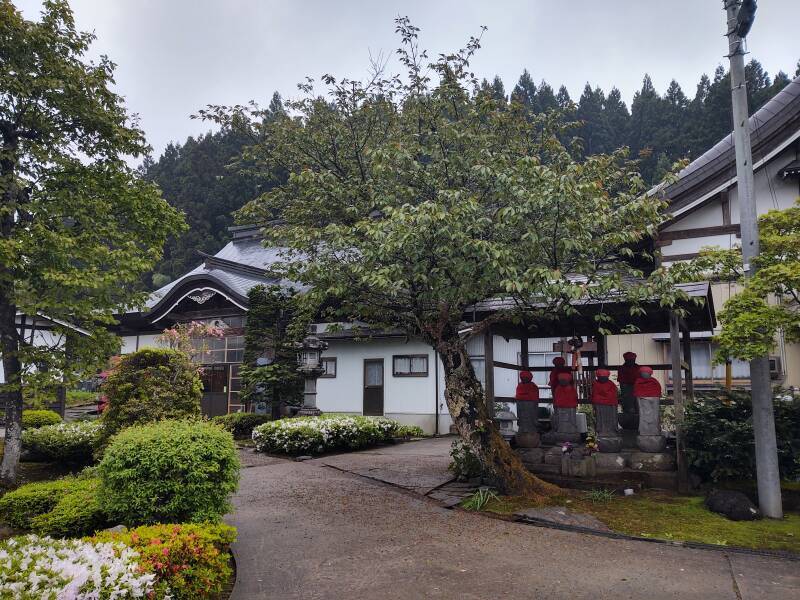
As usual, it has auxiliary Shintō shrines.

A path leads around the temple and up the slope behind it.
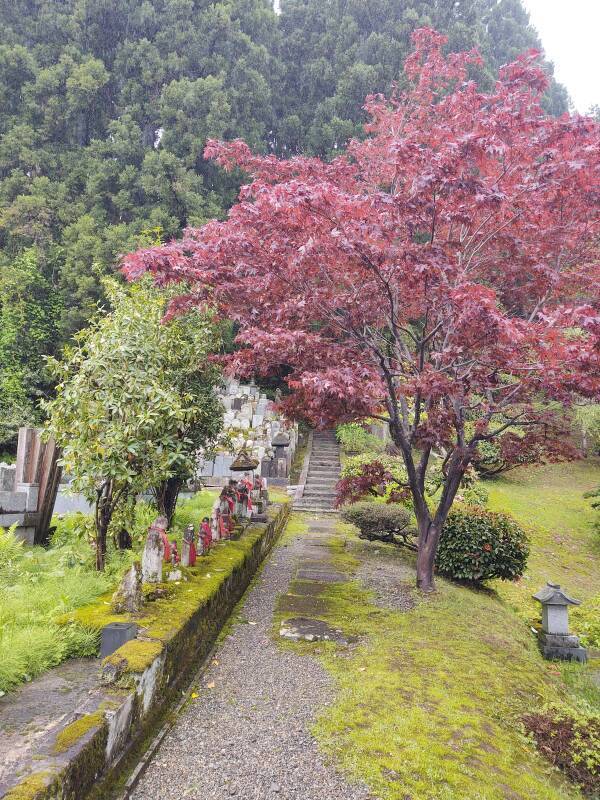


Stupas, Bodhisattvas, and red-bibbed Jizō figures among the grave markers make this area more Buddhist.

Further Through Haguromachi
Big torii, no hemp shime, so this one is just a large ryokan.
Many of the non-training ryokan specialize in shōjin-ryori, the ascetic cuisine of the Dewa Sanzan.

The remaining shukubo offer shugendō training. Originally that was quite rigorous, including a 100-day period that the student lived on their own on the mountain, praying and meditating. The 100-day period ends on New Year's Day, so the last week of September through the end of the year, getting into winter when several feet of snow accumulates here.
I think that there still are some programs like that. But many people do a one-week course. Or even a long weekend.

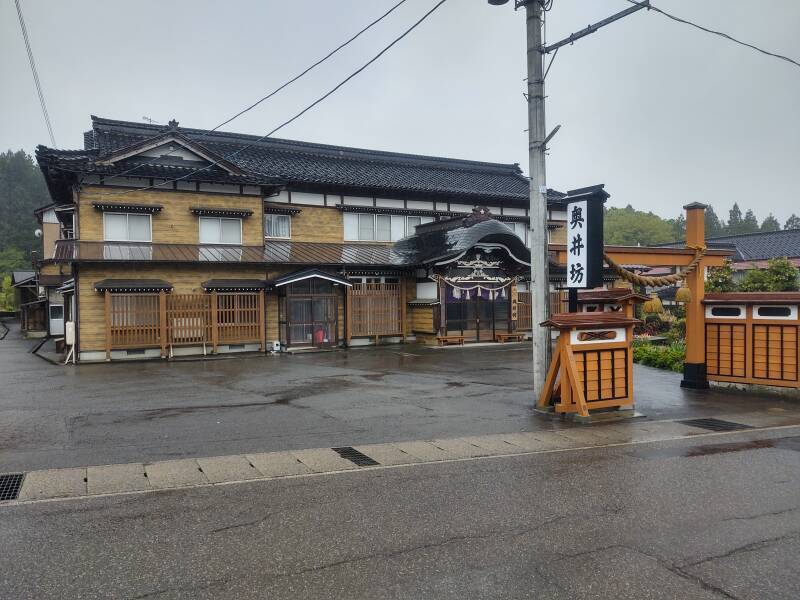

Here are more esoteric indicators that I can recognize. This house has a pair of nine-element vertically polarized 146 MHz Yagi-Uda beam antennas.
Between them, two omnidirectional whips.
The occupant has a ham radio license, and is active on FM voice or data modes on the two-meter band. For whatever historical reasons, FM and data modes typically use vertical polarization, while SSB, CW, and other weak-signal modes use horizontal.
The antenna design was invented in 1926 by Shintaro Uda of Tohoku Imperial University. His boss, Hidetsugu Yagi, contributed far less but filed the patent application without Uda's name on it and got the majority of the credit. Now it's usually referred to as "a Yagi".
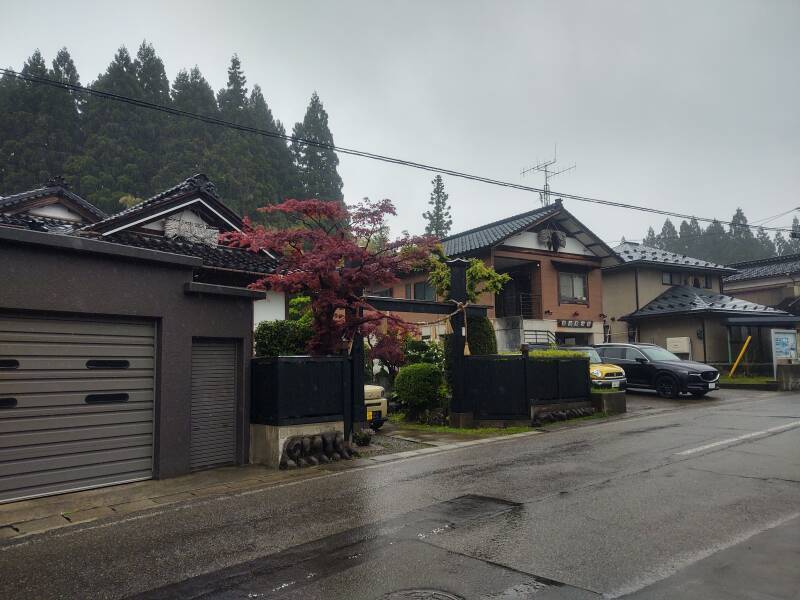

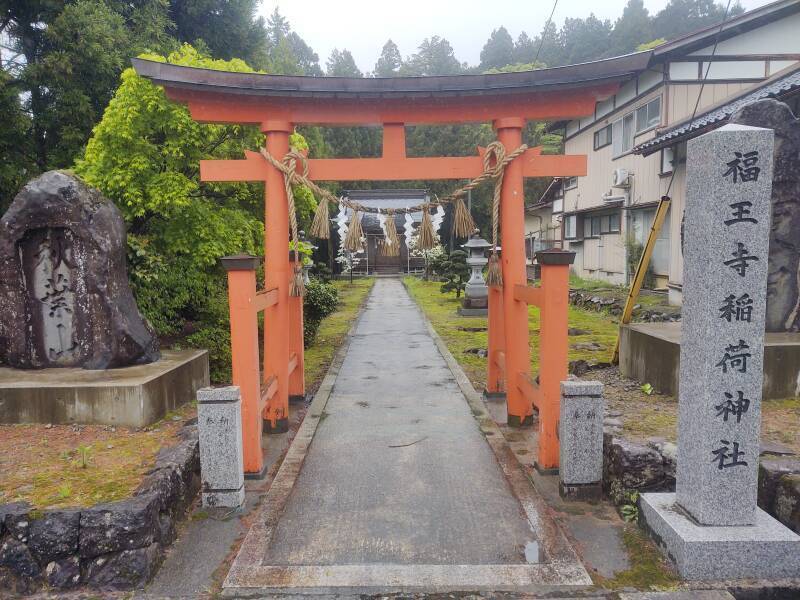

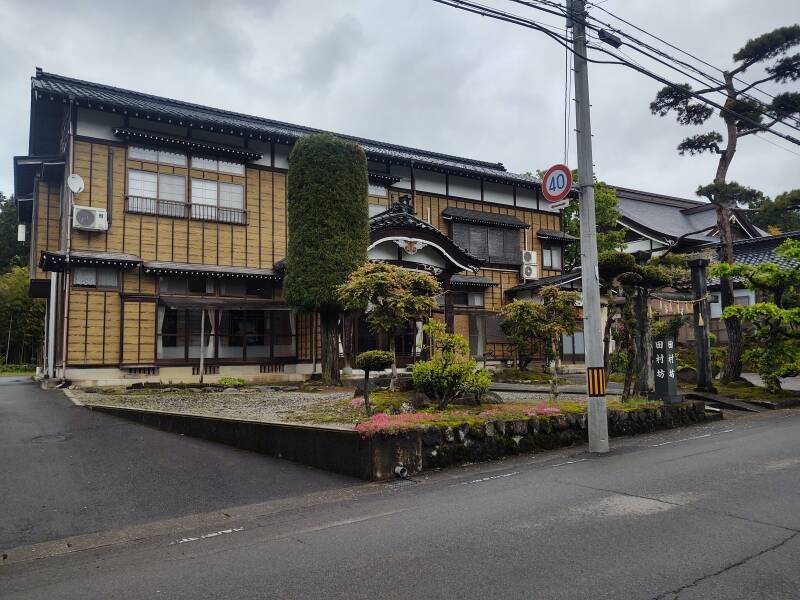
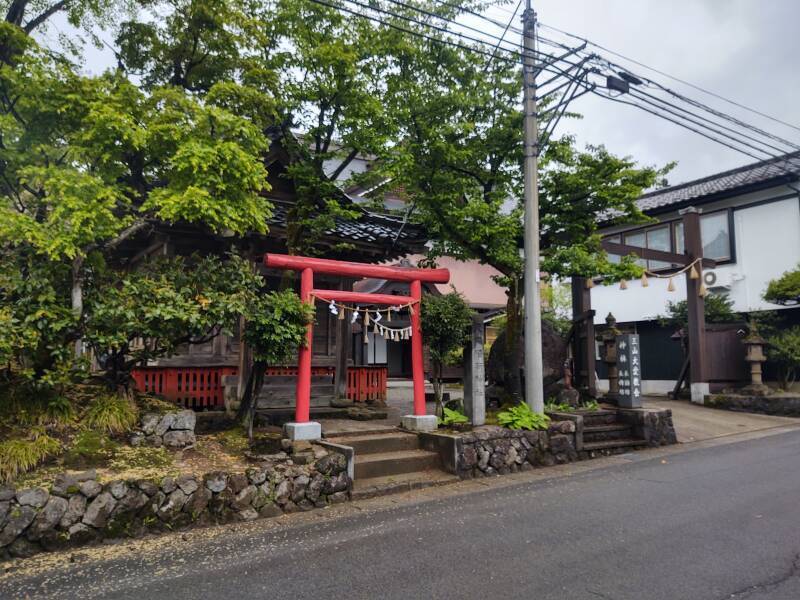
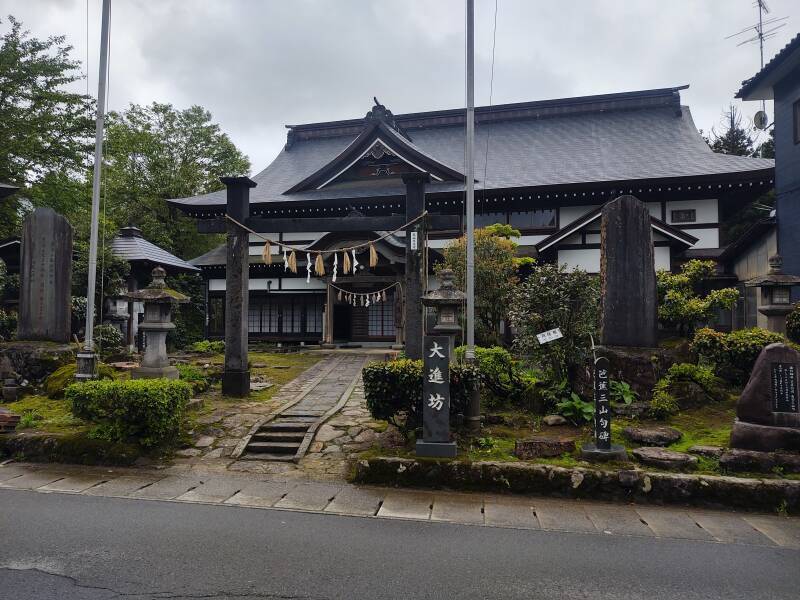
I really enjoyed my visit to Mount Haguro. As you can see from all of these pictures, it was dark and wet throughout my visit. But that just added to the atmosphere.
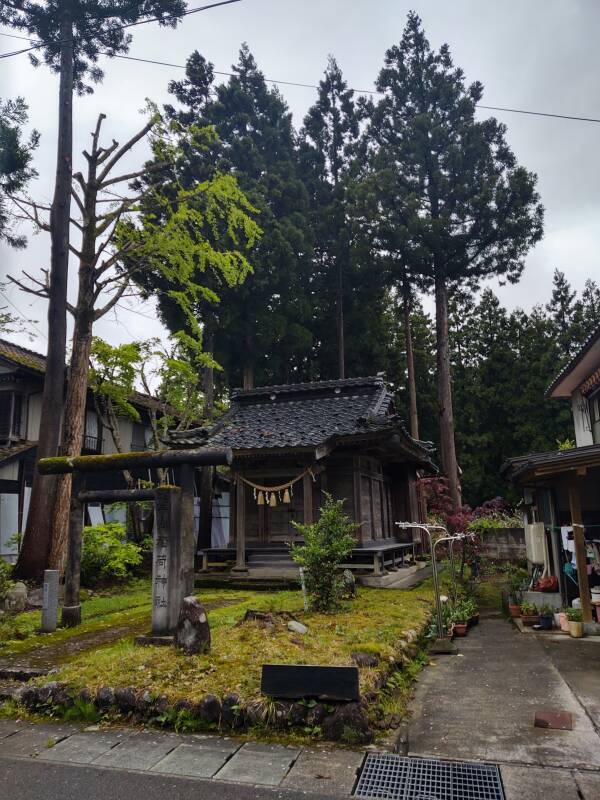
Now I would stay one more night at the ryokan, then travel by bus to Yamagata. I would spend one night there, leaving early the next morning for the Sendai airport and a flight south to Kyūshū and visits to two active volcanos, prehistoric tombs, and more.
Other topics in Japan:
